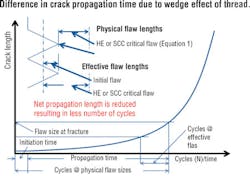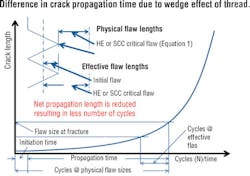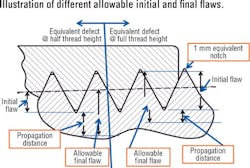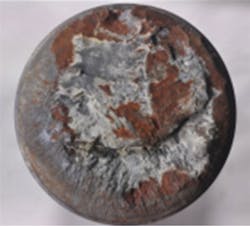New design procedure aims to improve subsea bolt reliability
Based on optimized preload, fatigue, and fracture
Gautam Chaudhury
Consultant
Since 2003, there have been continued failures of safety critical bolts used subsea in spite of replacing more than 10,000 bolts and efforts to improve manufacturing, construction, and installation. A paradigm shift in bolt design from design by maximum preload can achieve inherently reliable, long life, and robust bolts.
According to the Bureau of Safety and Environmental Enforcement (BSEE), there is a lack of urgency by the industry in developing new standards and procedure to resolve the issue. There is a possible systematic industry problem that requires immediate attention. Otherwise, there may be potential for a catastrophic event. Subject matter experts (SME) insist that hydrogen embrittlement and stress corrosion cracking (SCC) are the only reasons for these failures and cyclic fatigue plays no role, while mechanisms of failures were not understood (2).
All failed bolts had some service life indicating existence of fatigue crack initiation and propagation to a final fracture at critical flaw. The present “Preload and Forget” design procedure needs a change. It is proposed to test, validate, and use a newly developed design procedure, based on optimized preload, fatigue, and fracture, that will produce inherently safe and reliable bolts for long-term subsea use.
Bolt failure history
In connection to a recent Safety Alert (No 318), BSEE has reported that it is aware of the recurring problem of bolt failures in various safety critical components used in risers, BOPs, and other subsea components, with a concern of a systematic industry problem. In the safety alert, BSEE recommended the following:
- Verify documentation demonstrating that components satisfy properties specified by the original equipment manufacturer (OEM) and the latest industry standards
- Verify that all installation and maintenance procedures, including torque processes and values, satisfy OEM requirements
- Report any failures to OEMs and appropriate industry organizations in a timely manner.
In the December 2012 failure, BSEE found hydrogen induced stress corrosion cracking (HiSCC) with concurrence from an API task group of SMEs from the industry stakeholders. API and BSEE jointly recommended improve quality assurance/quality control (QA/QC) of heat treatment, pickling, coating, and baking processes primarily directed to reduce internal atomic hydrogen in coated bolts.
More comprehensive recommendations were made in 2003 as shown in the following excerpts from the QC-FIT report (1). “The suggested remedy for the 2003 Vetco Gray connector bolt failure was to redesign the bolts, bolt insert material design specification requirements (i.e. lower the material hardness, yield strength, and ultimate tensile strength), control the impressed current system voltage to -950mv maximum, eliminate thermal spray aluminum coating, increase bolt diameter size, and reduce the load by approximately 10% on the bolts.” However, cyclic fatigue was never included. According to the QC-FIT report (2016-04) (1), these remedy solutions were implemented long before December 2012 and other failures, yet failures continued.
There has been lack of urgency in industry response. The QC-FIT report (1) states: “Despite knowledge within the industry (the MMS, two major operators, one major drilling contractor, and one large OEM) of material hardness concerns involving marine service, there does not appear to have been any coordinated effort over the past 10 years to address the potential industry-wide safety issue through the revision or adoption of new industry standards. API standards committees have recently begun looking at this fastener material properties requirement issue and as a result, have issued new standards (API Spec 20E released and Spec 20F finalized). However, a more comprehensive incident and data sharing effort by the industry over the past 10 years might have highlighted this issue earlier and might have resulted in a more aggressive industry standards development response by the industry.” API Spec 20E and Spec 20F are not design standards.
In a letter to API (Jan. 22, 2016), BSEE Director Brian Salerno concluded by asking the industry for a concerted effort to create the necessary industry standard by elaborating his concern as follows:
“In fact, since the 2012 incident that resulted in the global recall, two additional connector failures have occurred. The latest failure occurred within the last 30 days. The fact that these failures involved equipment from the three primary manufacturers of this equipment suggests that this is a systematic industry problem that requires immediate attention.” The recall was for more than 10,000 bolts, and even some of these replaced bolts may have failed.
The director is right about a possible systematic common industry problem. It is unlikely that all three manufacturers will have the same QA/QC issue in terms of material or process. A possible systematic problem is that all bolts had high preload mean stress and did not include fatigue life calculation (4 and 5). The idea that higher preload means no cyclic fatigue and uncertainty on resulting preload by torque increase the probability of very high preload which reduces fatigue service life due to reduction in fatigue and fracture resistance. There is an urgent need for a radical solution that will produce robust and reliable bolts for the safety of offshore personnel and asset.
Forensic study
The QC-FIT evaluation by industry SMEs identified that these are hydrogen induced environmentally assisted cracking (EAC) failures and cyclic fatigue has no role, that is, only partial reasons for the failures are known (2). Accordingly, primary concerns were placed on QC of manufacturing processes. This assertion leads to atomic hydrogen source as internal to bolts (ASME F-16 Committee, 3). If so, the failures should have taken place wthin a day or so from the application of installation preload and failures would have been hydrogen embrittlement (HE). All bolts had some service life before failures means at least there have been some fatigue crack initiation and propagation. This indicates source of hydrogen, if any, was external, and most likely from cathodic protection. It is unlikely that suspected non compliance to OEM QC is the only root cause of failures. Cyclic fatigue may have played a role, in that, it determines the service life before a critical final fracture condition develops.
A more pragmatic and credible mechanism could be fatigue crack propagation of initial flaw cracks (existing or developed in service) to reach critical EAC flaws and final fracture. The time taken for this to happen is the service life the bolts had. High mean stress and some possible external hydrogen means critical flaw sizes for fracture were small. Based on faster crack propagation in sea water, bolt lives were short and almost entire fracture surface appeared as intergranular indicating only hydrogen induced EAC is responsible for all premature failures. Sample fracture surfaces do not actually represent this. In this regard, it is also to be noted that while effective flaws are large resulting in rapid crack propagation and early fracture, actual physical flaws are small so fatigue striation or beach marks are practically not noticable.
The conclusion that only EAC is responsible for early failures may stem from the generally held idea that adequately preloaded bolts do not suffer cyclic load fatigue (4, 5). This has been proven otherwise (6). Other safety critical industries include cyclic fatigue life calculation in their bolt design procedures.
In terms of cyclic fatigue of tension loaded bolts, couple of questions may be raised: Why have only some bolts failed? There are two possible reasons. Failed bolts had lower EAC resistance due to local high hardness (above threshold), possible higher hydrogen, and/or sharp cracks initiated due to exposure to extreme environmental load.
Why do fatigue tests of preloaded bolts generally not show fatigue? In open literature, there are reports of fatigue tests indicating near infinite fatigue life for preloaded bolts. A credible answer must come from appropriately designed tests. Without such tests, a pragmatic explanation is that fatigue tests with very high flange to bolt stiffness ratios lead to very small fraction of load amplitudes shared by bolts hence fatigue tests run-outs. For example, if we assume a fatigue exponent of 3.5, then for some moderate flange to bolt stiffness ratios of 4:1 and 5:1 there will be 128 (4^3.5) and 280 (5^3.5) times increase in number of test cycles, which are expected to be fatigue test run-outs. Alternately, effective stress ranges on bolt may be below crack growth threshold stress intensity (a function of stress and crack size).
Status of subsea bolt design
There is a possible trend to apply progressively more preload as more bolts fail. The following excerpt (4, 5) clearly shows how industry perception and procedure manage fatigue by preload rather than actually design for fatigue when it comes to bolts for subsea components. “As a safeguard to prevent fatigue failure of threaded components, a limit shall be placed on equipment so that no regular load encountered during working conditions causes a separation of the clamped joint of a threaded fastening system.” The bolt design procedure is just apply adequate preload to maintain flanges under compression, referred here as “Preload and Forget.”
Subsea components are carefully designed for fatigue taking due account of full service fatigue load histories, while bolts are just sized for a target preload of 66% of yield. This philosophy of 66% of yield preload hurts large bolts more because of larger effective initial flaw from higher thread height, hence reduced propagation life.
The preload concept has resulted in designers and SMEs focusing all the reliability and integrity issues only toward manufacturing, construction, and installation. Theoretically and by analysis it is proven (6) that tension loaded bolts experience a small portion of external static and dynamic loads subjected to flange. The combination of large effective flaws due to threads, reduced fatigue and fracture resistance due to high preload stress, and high strength susceptible material cause premature failure of some bolts leading to poor reliability. A paradigm shift in bolt design is essential to make them inherently safe and reliable.
Design and installation
Robust design, construction, and installation will provide the desired safeguard against premature failures. The aim is to adopt a wholistic approach to design, manufacture, and install bolts that are inherently reliable and not prone to premature HE or SCC types of failures. There has to be perfect balance on the conflicting elements (preload and mean stress, strength and hardness, corrosion protection and hydrogen) and a strict quality control in all areas of concerns.
According to the SMEs involved, the root cause of all failures were from hydrogen induced SCC (HiSCC). These are intergranular failures associated with three main constituent elements or contributing factors. A susceptible material, high tensile stress, and a corrosive or hydrogen environment. Depending on the combination of material (strength and hardness) and environment (hydrogen internal or external) EAC resistance varies. EAC resistance is highly sensitive to material hardness. In a way, hardness is a measure of material susceptibility. There is inconsistency in API recommendations. API 17A requires maximum hardness of 32 HRC with minimum yield of 92Ksi for subsea marine service when API 17D allows steel with maximum hardness of 34 HRC for use in subsea fasteners exposed to cathodic protection.
A safe design procedure for high strength bolts should start with an attempt to eliminate or reduce at least one of the three main contributing factors that lead to EAC. Over the last decade, efforts on preventing high strength bolt failures suggest corrosive environment, presence of some hydrogen, and occational mild susceptibile material are extremely difficult to avoid. For high strength materials experience has shown that probability of pockets of higher hardness and consequential failures is high. Sample fracture surfaces appear to show possible evidence of corrosion fatigue crack growth probability in presence of hydrogen from cathodic corrosion protection. Design life of bolt is the total time to initiate a sharp crack and propagate it to final critical size associated with the environment, material, and attending mean stress. Managing mean stress is probably the only option to end premature bolt failures.
In the existing bolt design procedure, “Preload and Forget,” bolt is preloaded as a percentage of proof or yield stress, typically 66% of yield. Sizing of bolt is then just ensuring bolt preload mean stress to 66% of yield which is maximum AISC allowable and equal to maximum expected environmental load. Due to uncertaintities associated with preload by torque, technicians tend to apply higher preload leading to possible true preload more than AISC allowable. Even if preload is correct, when part of the static external load is added total load exceeds the allowable 66% of yield.
Design of safety critical bolts for use in subsea components must be robust enough to withstand minor unintended non conformation to OEM construction and operation reuirements. We need bolts that are inherently safe, reliable, and robust. All bolts that failed enjoyed some short fatigue life before failure. A pragmatic robust design procedure must be based on ways to improve those short fatigue lives reliably to a level required by the functional and operational specifications. The procedure should be able to calculate fatigue life with acceptable probability of success and ensure construction and installation feasibility.
Quality construction and manufacture is also of utmost important. Poor QA and QC may lead to premature failure to an otherwise well designed bolt. All heat treatments, coating, baking, and thread forming must be followed through proper quality control and documentation procedure. OEM specification has to be followed and documented at all tiers of subcontractors. Ingot casting only should be used instead of continuous casting to avoid banding of material microstructure resulting in localized high hardness.
Installation procedure must ensure method and accuracy of preload application such that achieved preload is near equal to design specified value. Installation torque value should reflect the lubricant coefficient of friction, which is a major contributing factor for the resulting torque and attending stress. The coefficient varies considerably based on the type of lubricant. Torque tool must be properly calibrated as per OEM specification and procedure. Impressed current potential for cathodic protection should be maintained as close to -950mv as possible.
New design procedure
A pragmatic new design procedure for high strength bolts has been developed. It is a paradigm shift as opposed to a “Preload and Forget” procedure currently in practice. The new design procedure is based on optimization of preload, load sharing between flange and bolt, improving flaw size at fracture, and crack propagation work. Details of the work with full theoretical verifications will be documented in a future publication (6). The aim of the new design procedure is to make the bolts inherently safe, reliable, and robust for a given design service life. There is robustness at all stages to manage uncertaintities and reduce probability of failure to a negligibly low value.
The procedure will require some experimental validation tests to demonstrate acceptability to regular use. There is enormous benefit in safety and consequential cost savings in preventing the recurring bolt failures. In comparison, cost to test and validate the new design procedure is negligible. The leadershp team entrusted to manage and solve this problem is urged to give an opportunity to demonstrate feasibility of the new design procedure with the safety of offshore personnel and assets in mind.
Conclusions
There is a long history of high strength bolts failure and possible systematic industry problem which requires immediate attention, else, a catastrophic event may be waiting to happen.
Mitigation efforts so far have focused only on manufacturing QA, while evidences suggest inappropriate design is part of the problem too.
High level of preload (intentional or unintentional) may be a factor to premature failures. External static and dynamic loads must be duly accounted for with a detail fatigue design.
A pragmatic new design procedure has been developed (6). The procedure is a paradigm shift in tension loaded bolt design that will make subsea bolts inherently safe and reliable.
References
BSEE, QC-FIT Evaluation of Connector and Bolt Failures, “Summary of Findings” QC-Fit Report #2014-01, August 2014 and Addendum, QC-FIT Report #2016-04, February 2016.
Joseph Levine, ETB Chief and Dr. Candi Hudson, SRS Chief; “Framing the Issue-Connector Reliability”, August 29, 2016, Washington DC.
Joe Greenslade; International Fasteners Institute, ASTM F16 Fasteners Committee Info, 2015 BSEE Domestic and International Standards Workshop.
Parth D. Pathak, Cristopher, G. Kocurek, and Samuel L. Taylor; “Design Method Combining API and ASME Codes for Subsea Equipment for HPHT Conditions up to 25,000Psi Working Pressure and Temperature to 400 Deg F.” OTC 23928 Houston May 2013.
Parth D. Pathak, Cristopher, G. Kocurek, and Samuel L. Taylor; “Design Method Combining API and ASME Codes for Subsea Equipment for HP/HT Conditions up to 25,000Psi and 400 Deg F Temperature.”; SPE 169813, April 2014.
Gautam Chaudhury([email protected]); “Pragmatic New Solution Improves Reliability of Bolts Used in Subsea”, Accepted to be published, OTC 27591-MS, May 2017.



